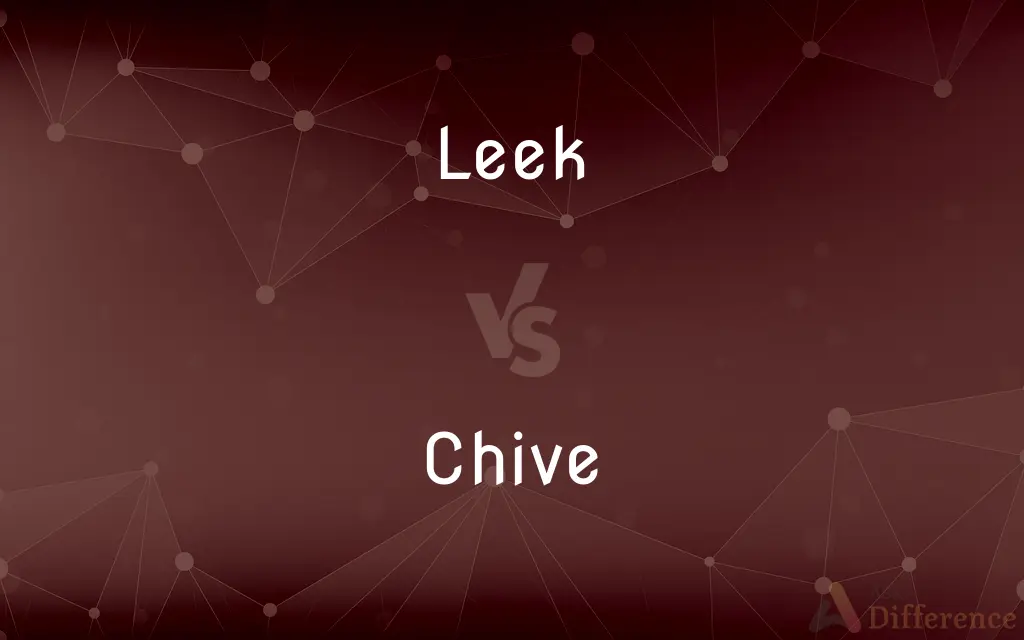Leek vs. Chive — What's the Difference?
By Fiza Rafique & Maham Liaqat — Updated on April 22, 2024
Leeks are larger, mild-flavored vegetables similar to onions, used as whole stalks in cooking, whereas chives are small, thin herbs used as a garnish or flavor enhancer with a delicate onion taste.

Difference Between Leek and Chive
Table of Contents
ADVERTISEMENT
Key Differences
Leeks, part of the Allium genus, are larger vegetables with a mild, sweet onion-like flavor. They are characterized by their long, white stalks that transition into flat, green leaves. Leeks are typically cooked and used as a primary ingredient in dishes like soups and pies. While, chives are also from the Allium family but are used as herbs. They are much smaller, featuring thin, tube-like green stalks, and are often used fresh, providing a subtle, onion-like flavor to dishes as a garnish.
Leeks are harvested for their stalks, which are thick and layered, similar to oversized green onions but with a milder taste and larger size. They require thorough cleaning to remove dirt trapped between the layers. Whereas, chives are harvested for their thin, fine leaves which are easy to chop and sprinkle over food, adding not just flavor but also a pop of color.
In the kitchen, leeks are quite versatile but require cooking to become tender and are often sautéed, boiled, or baked. They are a staple in many European dishes, such as the classic French potato leek soup. On the other hand, chives are rarely cooked as heat can diminish their flavor; instead, they are sprinkled over dishes just before serving, enhancing everything from baked potatoes to salads with a fresh, oniony zest.
The cultivation of leeks involves planting them deeply to blanch their stalks, thereby enhancing their sweetness and tender texture. Conversely, chives are low-maintenance plants, often found in herb gardens and pots, and can be easily grown even on a small balcony or windowsill.
While both leeks and chives are low in calories and rich in vitamins and minerals, their usage in cuisine distinctly sets them apart – leeks as a central ingredient providing bulk and flavor to hearty dishes, and chives as a finishing touch, offering a burst of flavor and color to lighter fare.
ADVERTISEMENT
Comparison Chart
Part of Plant
Stalks
Leaves (stems)
Flavor
Mild, sweet onion-like
Delicate, onion-like
Cooking Uses
Cooked (sautéed, boiled, baked)
Used fresh, garnish
Size
Large, thick stalks
Small, thin, tube-like
Typical Dishes
Soups, pies, stews
Garnish for potatoes, salads, soups
Compare with Definitions
Leek
Common in European cuisine, especially in hearty meals.
For the holiday meal, they made a traditional leek pie.
Chive
Easy to grow in herb gardens or pots.
She clipped a handful of chives from her kitchen window herb garden to use in cooking.
Leek
Large, white and green stalks, used mainly in cooked dishes.
He prepared a creamy potato leek soup for dinner.
Chive
Rarely cooked to preserve their flavor.
The chef added chives to the dish just before serving to maintain their fresh taste.
Leek
Cooked to soften and blend into dishes.
The leeks were sautéed until tender before adding them to the quiche.
Chive
Adds a burst of flavor and color as a garnish.
Fresh chives added a vibrant touch to the spring salad.
Leek
A vegetable similar to onions, with a mild, sweet flavor.
She added chopped leeks to the stew for a subtle onion flavor.
Chive
Small, thin, green tubes, used fresh.
He garnished the deviled eggs with a small sprinkle of chives.
Leek
Requires thorough cleaning to remove dirt between layers.
She carefully washed the leek to clean the dirt trapped in its layers.
Chive
A herb with a delicate, onion-like flavor.
She sprinkled chopped chives over the sour cream topping of the baked potatoes.
Leek
The leek is a vegetable, a cultivar of Allium ampeloprasum, the broadleaf wild leek. The edible part of the plant is a bundle of leaf sheaths that is sometimes erroneously called a stem or stalk.
Chive
Often chives A bulbous herb (Allium schoenoprasum) native to Eurasia, having clusters of usually pink to rose-violet flowers and cultivated for its long, slender, hollow leaves.
Leek
An edible plant (Allium ampeloprasum var. porrum) related to the onion and having a white, slender bulb and flat, dark-green leaves.
Chive
Chives The leaves of this plant used as a seasoning.
Leek
The vegetable Allium ampeloprasum var. porrum, having edible leaves and an onion-like bulb but with a milder flavour than the onion.
Chive
A perennial plant, Allium schoenoprasum, related to the onion.
Leek
Any of several species of Allium, broadly resembling the domesticated plant in appearance in the wild.
Chive
(in the plural) The leaves of this plant used as a herb.
Leek
A plant of the genus Allium (Allium Porrum), having broadly linear succulent leaves rising from a loose oblong cylindrical bulb. The flavor is stronger than that of the common onion.
Chive
(obsolete) The style and stigma of a flower, especially saffron.
Leek
Plant having a large slender white bulb and flat overlapping dark green leaves; used in cooking; believed derived from the wild Allium ampeloprasum
Chive
The spring onion; The green onion; the scallion.
Leek
Related to onions; white cylindrical bulb and flat dark-green leaves
Chive
(thieves' cant) A knife.
Chive
(thieves' cant) A file.
Chive
(thieves' cant) A saw.
Chive
(thieves' cant) To stab.
Chive
(thieves' cant) To cut.
Chive
A filament of a stamen.
Chive
A perennial plant (Allium Schoenoprasum), allied to the onion, having hollow cylindrical leaves used for seasoning. The young leaves are used in omelets, etc.
Chive
The bulbous herb Allium Schoenoprasum used fresh as a mild onion-flavored seasoning.
Chive
Perennial having hollow cylindrical leaves used for seasoning
Common Curiosities
Are chives used only as a garnish?
Primarily, yes; chives are used as a garnish or flavor enhancer due to their mild, onion-like flavor.
How should leeks be prepared for cooking?
Leeks should be thoroughly cleaned and typically chopped or sliced before being cooked.
What is the primary culinary use for leeks?
Leeks are primarily used as a vegetable in cooked dishes like soups, stews, and pies.
Is there a quick recipe using leeks?
A quick recipe could be sautéed leeks with butter, salt, and pepper, which makes a simple and delicious side dish.
Can chives be cooked?
Chives can be cooked, but are usually used fresh as cooking diminishes their delicate flavor.
Are there any specific dishes where chives are the main ingredient?
While chives are not typically the main ingredient, they play a crucial role in dishes like chive cream cheese or as a key garnish in gourmet potato dishes.
What dishes are enhanced by adding leeks?
Dishes such as potato leek soup, leek quiche, and various stews and casseroles are enhanced by adding leeks.
How can I ensure my chives stay fresh longer?
Keeping chives in a humid, cool environment and using them promptly ensures they stay fresh.
How are leeks and chives related?
Both leeks and chives belong to the Allium family, which also includes onions, garlic, and shallots.
Can chives be used in place of onions?
Yes, in dishes where a subtle onion flavor is desired, chives can be used as a milder substitute for onions.
What are the best growing conditions for leeks?
Leeks thrive in well-drained soil, with plenty of sunlight, and require deep planting to blanch their stalks.
What is the nutritional value of chives?
Chives are low in calories and rich in vitamins and minerals, particularly vitamin K and vitamin C.
How do you store fresh chives?
Fresh chives should be wrapped in a damp paper towel and stored in the refrigerator to maintain their freshness.
What part of the leek is edible?
The white and light green parts of the leek are edible and commonly used in cooking, while the darker green parts are tougher and often discarded.
Share Your Discovery

Previous Comparison
Matchbox vs. Matchbook
Next Comparison
Container vs. ReceptacleAuthor Spotlight
Written by
Fiza RafiqueFiza Rafique is a skilled content writer at AskDifference.com, where she meticulously refines and enhances written pieces. Drawing from her vast editorial expertise, Fiza ensures clarity, accuracy, and precision in every article. Passionate about language, she continually seeks to elevate the quality of content for readers worldwide.
Co-written by
Maham Liaqat













































